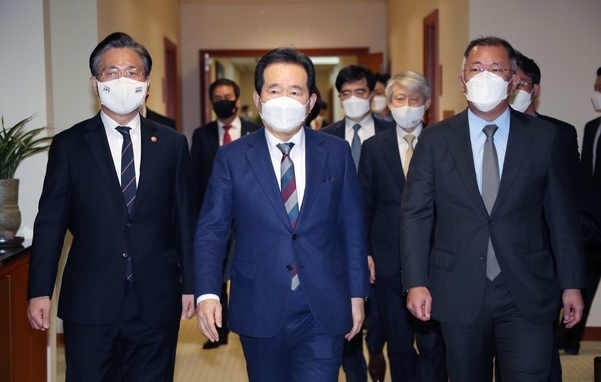Enter 2021.02.18 12:00
Review extension of tax benefits and maintain subsidy system
Supply of 2.83 million units by 2025…public purchase is obligatory for eco-friendly cars
The government announced plans to reduce electric vehicle prices by more than 10 million won by 2025 to secure economic feasibility at the level of internal combustion locomotives. It also proposed a plan to reduce the initial purchase cost of electric vehicles in half by introducing an electric vehicle’battery-less’ system.
On the morning of the 18th, Prime Minister Jeong Sye-gyun discussed the ‘4th Basic Plan for Eco-friendly Vehicles’ at Hyundai Motor’s Namyang Technology Research Center in Hwaseong-si, Gyeonggi-do. This basic plan will be applied for five years from this year to 2025.

An automobile industry official said, “In the case of the initial development of electric vehicles, the price per unit exceeded 100 million won, but the price gradually decreased during the mass production and mass production of parts.” In order to increase the mileage of electric vehicles in 2025, if more batteries are installed or other new technologies are applied, the estimated price reduction may be adjusted.”
The government also made plans to cut the initial purchase price in half by introducing a battery rental (lease) business for electric taxis. A pilot project for electric taxis and trucks will begin this year, and the business is planned to be expanded to hydrogen buses in 2022.
The government is also considering extending the reduction and exemption benefits such as individual consumption tax and acquisition tax for eco-friendly vehicles that expire at the end of this year.
In addition, the government is in a position that even if EV prices are cut by 2025, subsidies will not be completely abolished. There may be changes such as a decrease in subsidies depending on the conditions of each vehicle, but the subsidy system itself is maintained.
If you buy an electric car this year, you will receive up to 19 million won from the government and local governments, and up to 37.5 million won for hydrogen cars. Subsidies are higher for microcars or taxis. However, electric vehicles with a vehicle price of more than 90 million won cannot receive subsidies for purchasing eco-friendly vehicles (government and local expenses), and only 50% of the subsidy can be received if the vehicle price is less than 60 million won to 90 million won.
The government has set a goal of supplying eco-friendly vehicles to 2.83 million units by 2025. To this end, it plans to increase demand from this year by compulsory purchase of 100% eco-friendly vehicles by public institutions, introduction of a purchase target system for private consumers such as rental cars and large companies, and expansion of incentives for commercial vehicles.
In order to expand the electric vehicle charging infrastructure, the obligation to build electric vehicle chargers is imposed on existing buildings rather than new ones. Through this, it plans to secure chargers that account for more than 50% of the number of electric vehicles supplied. Next year, it is planning to increase the size of the compulsory charger construction from one per 200 parking spaces to one per 20 parking spaces. However, in areas where it is difficult to install chargers, such as in coalitions or multi-family houses, the policy is to open public charging facilities. It is also planning to supply more than 123 ultra-fast chargers that can drive 300km with a 20-minute charge this year.
The hydrogen vehicle charging infrastructure plans to build 450 units by 2025 to reach the charging station within 30 minutes. Specially, it plans to build 51 units (180 units nationwide) in Seoul and the metropolitan area this year.
Meanwhile, through technological innovation for electric vehicles and hydrogen vehicles, it has also made plans to increase the mileage of electric vehicles to more than 600km by 2025 and to improve fuel consumption by 15%. It also set a goal to commercialize all-solid-state batteries with enhanced safety by 2030. The hydrogen car plans to improve its mileage to more than 800 km and durability to more than 500,000 km by 2025, and to develop a liquefied hydrogen vehicle to reach the level of diesel trucks (1000 km, proven from 2026).
In addition, the government plans to help convert 500 parts companies into companies related to the future car industry by 2025.
An official from the Ministry of Industry said, “There may be a difference in the exact amount, but through the development of an electric vehicle platform and localization of parts and materials, the cost can be lowered. As a large part of the electric vehicle price is the battery price, the The initial purchase cost of an electric vehicle can be greatly reduced.”
